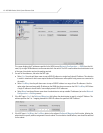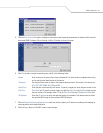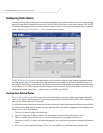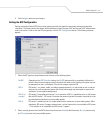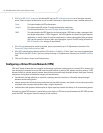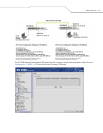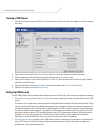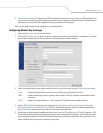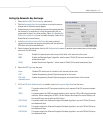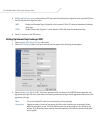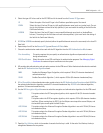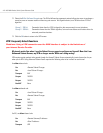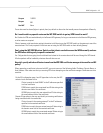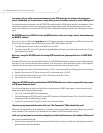
WS 2000 Wireless Switch System Reference Guide4-16
6. Select the ESP Type from the menu.
7. If ESP or ESP with Authentication is enabled, select an Encryption Algorithm from the menu.
8. Provide keys for both Inbound ESP Encryption Key and Outbound ESP Encryption Key. The length of the keys is
mandated by the selected encryption algorithm. These keys must match the opposite keys at the remote gateway. The
outbound key here must match the inbound key at the remote gateway, and the inbound key here must match the
outbound key at the remote gateway.
9. If ESP with Authentication is enabled, an authentication algorithm must be selected to be used with ESP from the
ESP Authentication Algorithm menu.
10. If ESP with Authentication is enabled, specify both the Inbound and Outbound ESP Authentication Keys.
11. Provide two (up to) eight-character hexadecimal values used to identify the inbound and outbound security association
created by the encryption algorithm. These values must match the reciprocal inbound/outbound SPI values configured
on the remote security gateway, so the local inbound key must match the remote outbound key, and so on. This value
should also be unique across all tunnels on the system.
12. Select Ok to return to the VPN screen.
None Disables ESP and the rest of the fields in this area will not be active.
ESP Enables Encapsulating Security Payload encryption for this tunnel.
ESP with
Authentication
Enables Encapsulating Security Payload encryption with authentication for this tunnel.
DES This option selects the DES encryption algorithm, which requires 64-bit (16-character hexadecimal)
keys.
3DES This option selects the 3DES encryption algorithm, which requires 192-bit (48-character hexadeci-
mal) keys. When creating keys for 3DES, the first 8 bytes cannot equal the second 8 bytes, and the
second 8 bytes cannot equal the third 8 bytes.
AES 128-bit This option selects the Advanced Encryption Standard algorithm in use with 128-bit (32-character
hexadecimal) keys.
AES 192-bit This option selects the Advanced Encryption Standard algorithm in use with 192-bit (48-character
hexadecimal) keys.
AES 256-bit This option selects the Advanced Encryption Standard algorithm in use with 256-bit (64-character
hexadecimal) keys.
MD5 Enables the Message Digest 5 algorithm, which requires 128-bit (32-character hexadecimal)
authentication keys.
SHA1 Enables Secure Hash Algorithm 1, which requires 160-bit (40-character hexadecimal) keys.



